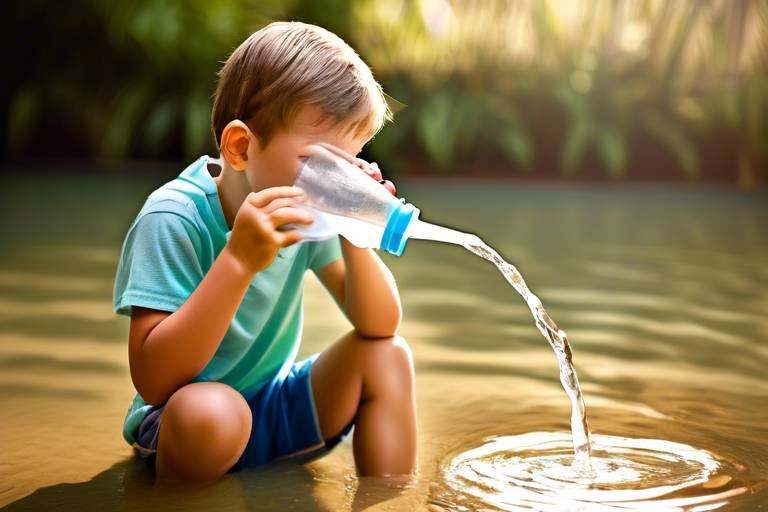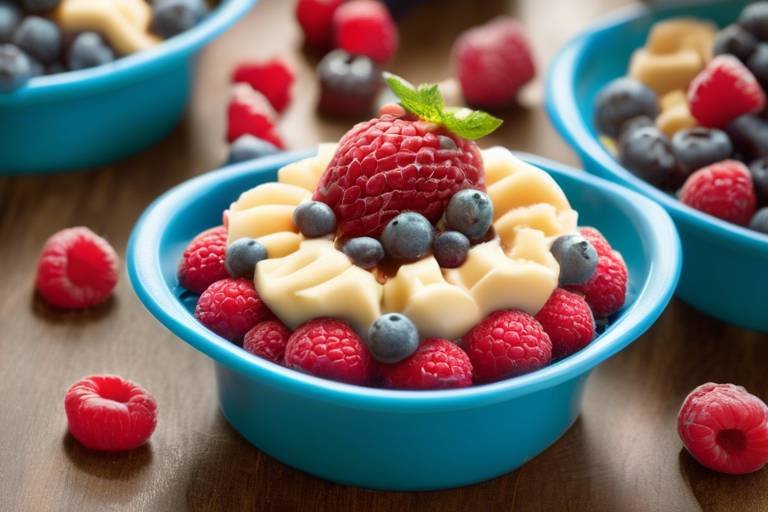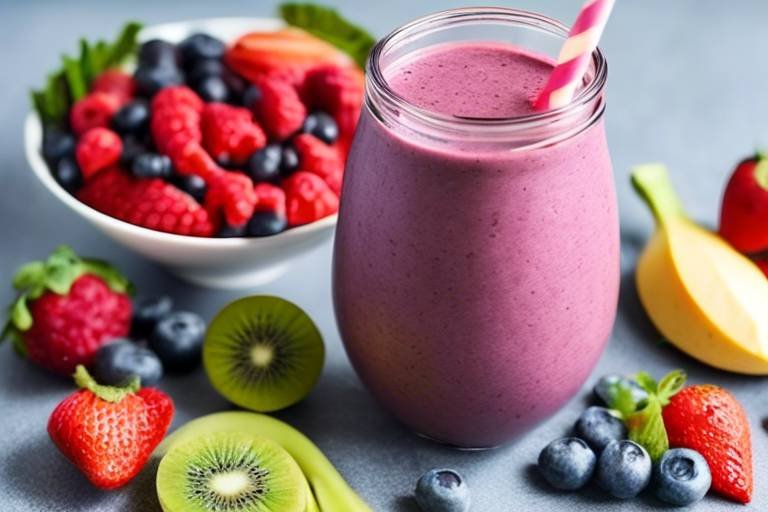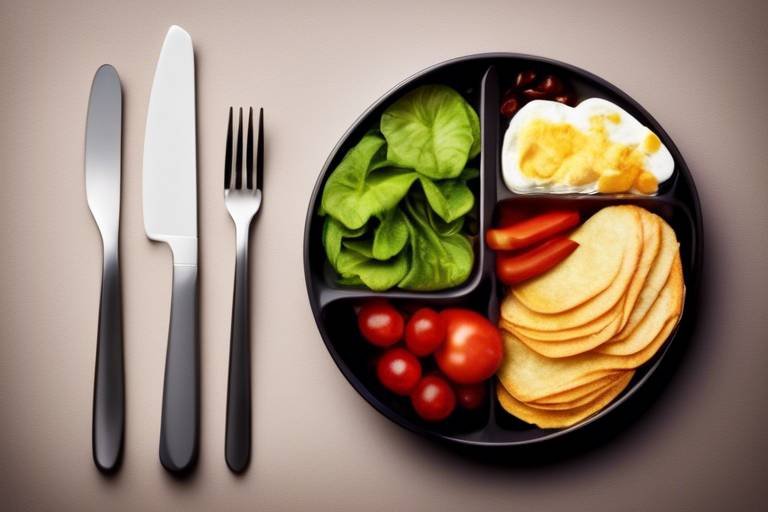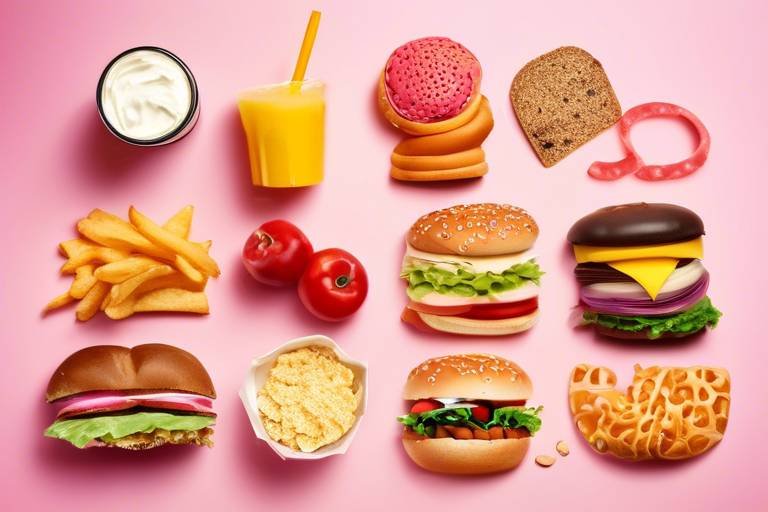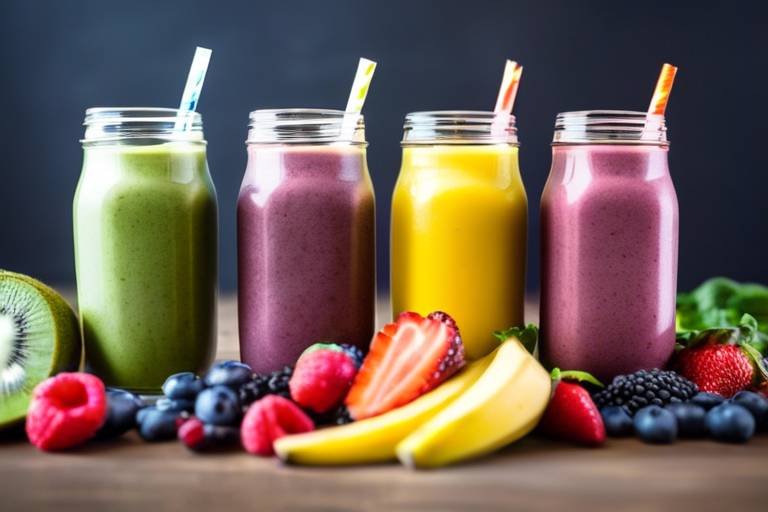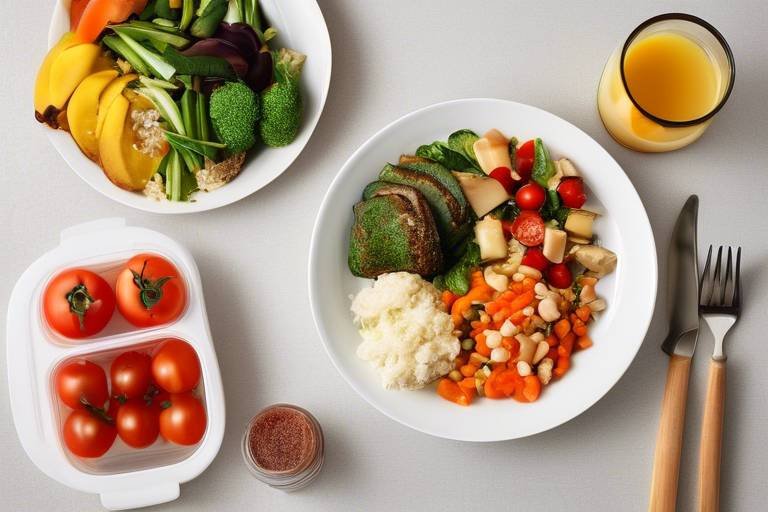How to Keep Your Family Hydrated: Tips and Tricks
Staying hydrated is not just a health trend; it's a vital component of our daily lives, especially for families. Imagine your body as a well-oiled machine; without enough fuel—in this case, water—it can start to sputter and slow down. This article provides essential strategies and insights for ensuring that your family stays properly hydrated, highlighting the importance of water intake and practical tips for incorporating hydration into daily routines. So, grab a glass of water, sit back, and let’s dive into the world of hydration!
Different age groups have varying hydration requirements. For instance, children, with their boundless energy and active play, need plenty of water to keep their little engines running smoothly. Adults, on the other hand, face different challenges, like work stress and physical exertion, that can affect their hydration levels. It’s essential to understand these needs to tailor water intake accordingly, ensuring that everyone in the family stays healthy and well-hydrated. Did you know that the general recommendation is to drink about 8 cups (64 ounces) of water a day? However, this can vary based on age, weight, and activity level. Here’s a quick breakdown:
| Age Group | Daily Water Intake |
|---|---|
| Children (4-8 years) | 5 cups (40 ounces) |
| Children (9-13 years) | 7-8 cups (56-64 ounces) |
| Teenagers (14-18 years) | 8-11 cups (64-88 ounces) |
| Adults | 8-13 cups (64-104 ounces) |
Hydration offers numerous health benefits, including improved digestion, better skin health, and enhanced cognitive function. Think of water as the magic elixir that keeps your body running smoothly. When you’re well-hydrated, you’re more likely to feel energetic, focused, and ready to tackle whatever the day throws at you. Understanding these advantages can motivate families to prioritize their fluid intake. For example:
- Improved Digestion: Drinking enough water helps break down food, making it easier for your body to absorb nutrients.
- Better Skin Health: Hydrated skin looks plumper and more youthful, reducing the appearance of wrinkles.
- Enhanced Cognitive Function: Staying hydrated can improve concentration and reduce the frequency of headaches.
Active families need to pay special attention to hydration. Physical activities increase fluid loss, making it crucial to replenish water before, during, and after exercise to maintain optimal performance and health. Have you ever noticed how a simple game of tag can leave everyone panting and thirsty? That’s your body signaling the need for hydration! Make it a family rule to drink water before heading out for a hike or a bike ride, and keep a water bottle handy during activities.
Incorporating hydrating snacks into your family's diet can boost overall water intake. Fruits and vegetables with high water content serve as delicious and nutritious options for enhancing hydration. Think watermelon, cucumbers, and oranges—these not only quench thirst but also provide essential vitamins and minerals. Next time you’re packing lunches, consider adding:
- Watermelon slices
- Carrot sticks with hummus
- Cucumber slices with a sprinkle of salt
If plain water is unappealing, flavoring it with fruits, herbs, or spices can make hydration more enjoyable. This simple trick encourages family members to drink more throughout the day. Try infusing water with slices of lemon, mint leaves, or even berries. It’s like giving your water a refreshing makeover! You might just find that everyone in the family starts reaching for their water bottles more often.
Recognizing the signs of dehydration is crucial for timely intervention. Common symptoms include thirst, dry mouth, and fatigue. If you notice that your little ones are unusually cranky or if you’re feeling sluggish, it might be time to sip some water. Understanding these signs can help prevent more severe health issues. Remember, it’s easier to stay ahead of dehydration than to catch up once it hits!
Establishing a daily hydration routine can help ensure that family members drink enough water consistently. Simple strategies, such as scheduled water breaks, can significantly improve overall hydration. For instance, you might set specific times during the day for everyone to gather and drink a glass of water together. This not only reinforces the habit but also turns hydration into a fun family activity!
Utilizing technology, such as hydration reminder apps, can assist families in tracking their water intake. These tools can provide motivation and accountability for maintaining proper hydration habits. Some apps even gamify the experience, turning drinking water into a fun challenge. Why not make it a family competition to see who can drink the most water in a week? The winner could get a fun prize, like choosing the next family movie night film!
Engaging children in fun activities centered around hydration can foster healthy habits. Creative games and challenges can make drinking water exciting and encourage kids to stay hydrated. For example, you could create a “water drinking chart” where kids earn stickers for each glass they drink. Once they collect a certain number of stickers, they can trade them for a small reward. It’s all about making hydration a fun part of their routine!
Q: How can I tell if my child is dehydrated?
A: Look for signs like dry mouth, fatigue, and dark yellow urine. If you notice these symptoms, encourage them to drink water.
Q: Can I rely solely on drinks other than water for hydration?
A: While other beverages can contribute to hydration, water is the best option. Sugary drinks can lead to other health issues.
Q: How much water should I drink during exercise?
A: Aim for about 7-10 ounces of water every 10-20 minutes during exercise, depending on the intensity of the activity.

Understanding Hydration Needs
When it comes to hydration, one size definitely does not fit all. Just like how a toddler's toy is different from a teenager's gadget, the hydration needs of different age groups vary significantly. Understanding these needs is the first step in ensuring that your entire family stays healthy and well-hydrated. For instance, infants and toddlers have a higher percentage of water in their bodies compared to adults, making them more susceptible to dehydration. It's crucial to keep an eye on their fluid intake, especially during hot weather or when they're active.
As children grow, their hydration requirements evolve. School-aged kids, who are often engaged in sports and play, need to replenish fluids regularly to maintain their energy levels. On the other hand, adults have different hydration needs, influenced by factors such as activity level, climate, and even diet. For example, if you're someone who enjoys spicy foods or caffeine, your body may require more water to balance things out.
The elderly also have unique hydration needs. As we age, our sense of thirst diminishes, which can lead to unintentional dehydration. This makes it essential to encourage older family members to drink water regularly, even if they don't feel thirsty. To help you understand the hydration needs across different age groups, here’s a simple table:
| Age Group | Daily Water Intake Recommendation |
|---|---|
| Infants (0-12 months) | Approximately 0.7 liters (about 24 ounces) |
| Children (1-8 years) | 1.2-1.6 liters (about 40-54 ounces) |
| Teens (9-18 years) | 1.6-2.6 liters (about 54-88 ounces) |
| Adults (19-50 years) | 2.7-3.7 liters (about 91-125 ounces) |
| Older Adults (51+ years) | 2.7-3.7 liters (about 91-125 ounces) |
In addition to age, factors such as climate and physical activity play a significant role in determining hydration needs. For example, if you live in a hot climate or are engaging in intense workouts, you may need to increase your water intake. It's not just about drinking water; it's also about replenishing electrolytes lost through sweat. This is where sports drinks or electrolyte-rich foods can come into play, especially for active family members.
So, how can you ensure that everyone in your family meets their hydration needs? Start by making water easily accessible. Keep water bottles handy, and encourage regular breaks for hydration throughout the day. You might even consider creating a fun hydration challenge to motivate everyone! Remember, staying hydrated is not just a summer activity; it's a year-round commitment that supports overall health and well-being.

Benefits of Staying Hydrated
Staying hydrated is not just about quenching your thirst; it's about fueling your body with the essential fluids it needs to function optimally. The benefits of proper hydration are numerous and can significantly impact your family's overall health and well-being. When you think about it, water is like the oil that keeps the engine running smoothly. Without it, everything can start to sputter and stall. So, let’s dive into some of the key benefits that come from drinking enough water every day.
First and foremost, hydration plays a critical role in digestion. When you consume water, it aids in breaking down food, allowing your body to absorb nutrients more effectively. Imagine trying to drive a car without enough fuel; it just won’t go! Similarly, without adequate water intake, your digestive system can become sluggish, leading to discomfort and issues like constipation. Keeping hydrated ensures that everything moves smoothly through your system.
Another significant advantage of staying hydrated is its positive effect on your skin health. Water acts as a natural moisturizer, helping to maintain skin elasticity and combat dryness. Think of your skin as a sponge; when it's dry, it becomes brittle and cracks. However, when it’s well-hydrated, it remains plump and youthful. Drinking enough water can help reduce the appearance of fine lines and give your skin that healthy glow we all desire.
Moreover, hydration is crucial for cognitive function. Studies have shown that even mild dehydration can impair concentration, alertness, and short-term memory. Picture trying to solve a puzzle with missing pieces; it’s frustrating, right? That’s how your brain feels when it doesn’t have enough water. Keeping your family hydrated not only supports better focus during school or work but also enhances overall mental clarity.
In addition to these benefits, hydration plays a vital role in regulating body temperature. When you’re active, your body sweats to cool down, and without enough water, it can lead to overheating. This is especially important for families who love outdoor activities or sports. Staying hydrated before, during, and after exercise is key to maintaining peak performance and avoiding heat-related illnesses.
To summarize, here are some of the essential benefits of staying hydrated:
- Improved digestion: Aids in breaking down food and nutrient absorption.
- Better skin health: Keeps skin moisturized and elastic.
- Enhanced cognitive function: Supports concentration and mental clarity.
- Regulated body temperature: Helps maintain optimal body heat during physical activities.
By understanding these benefits, families can be motivated to prioritize their hydration habits. Remember, keeping a water bottle handy, encouraging water breaks, and integrating hydrating foods into meals can make all the difference. So, the next time you're reaching for that sugary drink, consider the incredible benefits of good old-fashioned water instead!
1. How much water should my family drink daily?
The general recommendation is about 8-10 cups of water per day for adults, while children should drink according to their age and activity level. Adjustments may be needed based on physical activity and climate.
2. Can I rely on other beverages for hydration?
While other beverages like juice and milk contribute to hydration, water is the best choice for maintaining fluid balance without added sugars or calories.
3. What are some signs that my family is dehydrated?
Common signs include thirst, dark yellow urine, fatigue, and dizziness. If you notice these symptoms, encourage your family to drink more fluids.
4. How can I encourage my kids to drink more water?
Make it fun! Use colorful water bottles, add fruits for flavor, or create games around hydration to make drinking water exciting.

Hydration and Physical Activity
When it comes to staying active, hydration is key. Think of your body as a car; just as a car needs fuel to run smoothly, your body requires water to perform at its best. Whether you’re hitting the gym, playing a sport, or simply enjoying a family hike, it’s crucial to keep your fluid levels topped up. Did you know that even a small decrease in hydration can lead to a dip in performance? That's right! Just losing 1-2% of your body weight through sweat can impair your physical abilities.
As a family, it’s important to recognize that different activities lead to varying levels of fluid loss. For example, a leisurely walk may not require as much hydration as a high-intensity workout. Here’s a quick breakdown of how much water you might need based on your activity level:
| Activity Level | Recommended Water Intake |
|---|---|
| Light Activity (e.g., walking) | 8-10 cups/day |
| Moderate Activity (e.g., cycling, dancing) | 10-12 cups/day |
| High Activity (e.g., running, sports) | 12-15 cups/day |
Also, don’t forget that hydration isn’t just about drinking water before or after exercise. It’s vital to drink water during physical activity as well. Keep a water bottle handy, and make it a habit to take sips regularly. For instance, if you’re out for a run, aim to drink about 7-10 ounces every 10-20 minutes. This will help replenish fluids lost through sweat and keep your energy levels up.
Another fun way to encourage hydration during physical activity is to turn it into a game! For example, every time your family completes a round of a sport or finishes a lap around the park, reward everyone with a refreshing drink. This not only keeps hydration exciting but also fosters a sense of teamwork and motivation.
In conclusion, staying hydrated while being active is essential for maintaining energy, focus, and overall health. So, next time your family gears up for some fun, remember to keep those water bottles filled and make hydration a priority!
- How much water should I drink during exercise?
It’s generally recommended to drink about 7-10 ounces every 10-20 minutes during physical activity. - What are the signs that I am dehydrated?
Common signs include thirst, dry mouth, fatigue, and dark yellow urine. - Can I hydrate with drinks other than water?
Yes! While water is the best option, you can also hydrate with sports drinks, coconut water, or water-rich fruits and vegetables.

Hydrating Snacks
When it comes to keeping your family hydrated, snacks can play a surprisingly significant role. You might not think of snacks as a source of hydration, but many fruits and vegetables are packed with water and can help boost your family's fluid intake. Imagine biting into a crisp cucumber or enjoying a juicy watermelon slice—these snacks not only satisfy hunger but also replenish lost fluids. In fact, certain fruits and veggies can contain over 90% water! Isn't that amazing?
Incorporating hydrating snacks into your daily routine can be a fun and delicious way to ensure your family stays well-hydrated. Consider setting up a colorful fruit and veggie platter that showcases these hydrating options. Here’s a quick look at some of the best hydrating snacks you can include:
| Snack | Water Content (%) |
|---|---|
| Watermelon | 92 |
| Cucumber | 95 |
| Strawberries | 91 |
| Cantaloupe | 89 |
| Oranges | 86 |
As you can see from the table, options like watermelon and cucumbers are not only refreshing but also incredibly hydrating. You can get creative by making smoothies with these fruits, adding them to salads, or even blending them into popsicles for a fun treat on hot days. Kids love popsicles, and you can make them healthier by using real fruit juice and chunks of hydrating fruits.
Another great idea is to involve your family in preparing these hydrating snacks. Set up a “snack station” where everyone can create their own combinations. This not only makes the process interactive but also encourages kids to try new things. Who knows? They might discover a new favorite snack! Remember, the key is to make hydration a fun and engaging part of your family's lifestyle.
So, the next time you’re thinking about what to serve for a snack, consider reaching for those hydrating options. Not only will they help keep your family hydrated, but they’ll also provide essential vitamins and minerals that contribute to overall health. Hydration can be delicious!

Flavoring Water
Let’s face it: plain water can sometimes feel a bit boring, right? But here’s the good news—there are countless ways to jazz it up! Flavoring water is not just a fun twist; it’s an incredible way to encourage your family to drink more throughout the day. Imagine sipping on a refreshing drink that not only quenches your thirst but also tantalizes your taste buds!
One of the simplest methods to enhance your water is by adding fresh fruits. Think of vibrant slices of lemons, limes, or oranges—these citrus fruits not only provide a zesty flavor but also a boost of vitamin C. You could even try a combination of berries like strawberries and blueberries for a sweet, fruity infusion. The best part? You can mix and match to find your family’s favorite combinations!
If you’re feeling a bit adventurous, consider adding herbs to your water. Mint is a classic choice that adds a refreshing taste, while basil can give your drink a unique twist. Just a few leaves can transform a glass of water into a delightful experience. And don’t forget about spices! A pinch of ginger or a sprinkle of cinnamon can add warmth and depth to your hydration routine.
For those who love a little fizz, sparkling water can be an exciting alternative. You can infuse it with the same fruits and herbs mentioned earlier, creating a bubbly, refreshing drink that feels like a treat! Plus, it’s a great way to cut down on sugary sodas, which can be a hidden enemy when it comes to hydration.
To make it even easier, you might want to consider preparing flavored water in advance. Just grab a large pitcher and fill it with water, then add your chosen ingredients. Let it sit in the fridge for a few hours or overnight. This allows the flavors to meld beautifully, giving you a delicious drink ready to go whenever you need it. You can even label the pitcher with the flavor combo to make it fun for the kids!
Remember, hydration doesn’t have to be a chore. By making water more appealing, you’re not only helping your family stay hydrated but also creating a positive relationship with drinking water. So go ahead, get creative, and make hydration a flavorful adventure!
- How much water should my family drink daily? The general rule is to aim for about 8-10 cups per day, but this can vary based on age, activity level, and climate.
- Can I use frozen fruits for flavoring water? Absolutely! Frozen fruits can add flavor and keep your water cool, making them a great option.
- How long can I keep flavored water in the fridge? Flavored water can typically last for 2-3 days in the fridge. Just be sure to check for any changes in smell or taste!
- Are there any fruits or herbs I should avoid? While most fruits and herbs are safe, it’s best to avoid anything that may spoil quickly, like dairy products or certain delicate herbs.

Signs of Dehydration
Recognizing the is crucial for keeping your family healthy and happy. Dehydration can sneak up on you, especially when you're busy or caught up in activities. It’s like that sneaky thief that comes in and steals your energy, leaving you feeling drained and lethargic. So, what should you look out for? Here are some common symptoms that can signal your body is begging for more water:
- Thirst: This is the most obvious sign. If you or your family members are feeling thirsty, it's your body’s way of saying, “Hey, I need some hydration!”
- Dry Mouth: A dry or sticky feeling in your mouth can indicate that you need more fluids. It’s like your mouth is sending out a distress signal!
- Fatigue: Feeling unusually tired or sluggish? Dehydration can sap your energy levels, making even the simplest tasks feel like climbing a mountain.
- Headaches: If you notice a headache coming on, it might be your body's way of saying it’s time for a drink. Dehydration can lead to tension headaches, which can be quite uncomfortable.
- Dark Urine: If you notice that your urine is darker than usual, it could be a sign that you’re not drinking enough water. Ideally, your urine should be a light yellow color.
These symptoms can vary from person to person, and they can be particularly subtle in children and older adults. It’s essential to stay vigilant and encourage everyone in the family to drink water regularly, even if they don’t feel thirsty. Think of hydration as a daily habit, much like brushing your teeth. Just as you wouldn’t skip that, don’t skip your water intake!
In summary, staying aware of these signs can help prevent dehydration from sneaking up on you. By recognizing the symptoms early, you can take action and ensure that everyone stays properly hydrated, keeping your family feeling their best. Remember, hydration is not just about drinking water; it’s about making a conscious effort to maintain that balance every day.
Here are some common questions that families often have about hydration:
- How much water should each family member drink daily? While it varies by age and activity level, a general guideline is to aim for about 8-10 cups of water a day for adults, and for children, it can range from 4-8 cups depending on their age.
- Can I rely on beverages other than water for hydration? Yes! While water is the best option, other beverages like herbal teas and even certain fruits and vegetables can contribute to your daily fluid intake.
- What are some fun ways to encourage kids to drink more water? You can create a hydration challenge, use colorful cups, or even infuse water with fruits to make it more appealing!

Setting a Hydration Routine
Establishing a daily hydration routine is crucial for ensuring that your family drinks enough water consistently. Think of hydration as a daily ritual, much like brushing your teeth or having breakfast. It’s about creating habits that become second nature. One effective strategy is to incorporate scheduled water breaks throughout the day. For instance, you can set specific times when everyone in the family takes a moment to drink a glass of water. This could be during meals, after school, or even at the start of a family movie night. By making hydration a part of these daily activities, you’re more likely to keep everyone on track.
Another helpful tip is to place water bottles in easily accessible locations around the house. Whether it’s on the kitchen counter, in the living room, or even in the car, having water within reach makes it much easier to grab a drink. You might even consider investing in fun, colorful water bottles or cups that appeal to your kids. When they have a vessel they love, they’ll be more inclined to use it regularly. Plus, you can encourage them to personalize their bottles with stickers or designs, making hydration feel like a fun activity rather than a chore.
Furthermore, consider creating a family challenge to boost your hydration efforts. For example, you could set a goal for each family member to drink a certain amount of water by the end of the day. You can track progress on a chart or use an app to make it more engaging. Celebrating small victories, like reaching the goal for a week straight, can build excitement around staying hydrated. This not only reinforces the habit but also fosters a sense of teamwork among family members.
In addition to these strategies, it’s essential to lead by example. If your kids see you drinking water regularly, they are more likely to mimic that behavior. Share with them how good it feels to stay hydrated, perhaps by discussing how it boosts your energy or improves your mood. When they understand the importance of hydration and see you practicing it, they’ll be more motivated to follow suit.
Finally, remember that consistency is key. Just as you wouldn’t skip brushing your teeth every day, make hydration a non-negotiable part of your family’s routine. Over time, these habits will become ingrained, ensuring that everyone stays hydrated and healthy.
- How much water should each family member drink daily? The general recommendation is about 8 cups (64 ounces) for adults, while children’s needs vary based on age and activity level.
- What are some signs my family is dehydrated? Look out for symptoms like dry mouth, fatigue, and dark-colored urine.
- Can we drink other beverages instead of water? While other fluids contribute to hydration, water is the best choice. Be mindful of sugary drinks, as they can lead to dehydration.
- How can I make water more appealing to my kids? Try infusing water with fruits, herbs, or even using fun ice cubes to make drinking water exciting.

Using Reminders and Apps
In our fast-paced lives, it's easy to forget to drink enough water throughout the day. That's where technology comes to the rescue! Using reminders and hydration apps can transform your family's hydration habits into a seamless part of your daily routine. Imagine this: you're busy with work, the kids are running around, and suddenly you realize it’s been hours since anyone has had a sip of water. With the help of hydration apps, you can set reminders that ping you at regular intervals, gently nudging you to take a break and hydrate.
Many hydration apps come with customizable features that allow you to tailor your reminders according to your family's specific needs. For example, you can set different goals based on age and activity levels. This ensures that everyone in the family, from your energetic toddler to your active teenager, is reminded to drink the right amount of water. Some apps even offer fun notifications, like “Time to hydrate, superstar!” which can put a smile on your face while promoting healthy habits.
Moreover, these apps often track your water intake, providing visual representations of your progress. Seeing how much water you’ve consumed can be incredibly motivating. You can even compete with family members through some apps, turning hydration into a fun family challenge. For instance, you might have a friendly competition to see who can drink the most water in a week, with a small prize for the winner. This not only encourages everyone to drink more but also fosters a sense of teamwork and accountability.
Another fantastic feature of many hydration apps is the integration with wearable devices. If you or your family members use smartwatches or fitness trackers, these devices can remind you to hydrate based on your activity levels. After an intense workout, your watch might suggest a specific amount of water to drink, helping you replenish lost fluids efficiently. This synergy between technology and hydration can make a significant difference in your family's overall health and wellness.
So, if you haven't already, consider downloading a hydration app today. Take advantage of technology to ensure your family stays hydrated and healthy. Remember, a simple reminder can go a long way in establishing a consistent hydration routine. Why not make hydration a family affair and turn it into a fun, engaging activity? After all, staying hydrated is not just about drinking water; it's about creating a lifestyle that values health and wellness.
- What are some popular hydration apps?
Some popular hydration apps include WaterMinder, Hydro Coach, and My Water Balance. These apps offer various features to help track your water intake and send reminders. - How much water should each family member drink?
Water intake varies by age, weight, and activity level. Generally, adults should aim for about 2-3 liters daily, while children require less based on their age and size. - Can I drink beverages other than water?
Yes! While water is the best choice, other beverages like herbal teas and infused waters also contribute to hydration. Foods with high water content, such as fruits and vegetables, are beneficial too.

Encouraging Kids to Drink Water
Getting kids to drink water can sometimes feel like a Herculean task. With colorful sodas and sugary juices constantly vying for their attention, it’s crucial to find creative ways to make water appealing. One effective strategy is to turn hydration into a fun game. For example, you could create a “Water Challenge” where the family competes to see who can drink the most water throughout the day. You can even set up a point system where kids earn rewards for reaching their hydration goals. This not only motivates them but also makes drinking water feel like an exciting achievement rather than a chore.
Another engaging method is to personalize their water bottles. Letting your kids choose their own water bottles—perhaps featuring their favorite characters or colors—can instill a sense of ownership and pride. When they have a bottle they love, they’re more likely to carry it around and sip from it frequently. You can also encourage them to decorate their bottles with stickers, making the act of drinking water a more personalized experience.
Incorporating fun flavors can also do wonders. You can create a “Water Bar” at home where kids can choose from a variety of fruits, herbs, or even edible flowers to flavor their water. For instance, slices of lemon, strawberries, or mint leaves can transform plain water into a refreshing treat. This not only enhances the taste but also introduces them to the idea that water can be both healthy and delicious.
Finally, leading by example is one of the most powerful ways to encourage kids to drink more water. When they see you prioritizing hydration, they’re more likely to follow suit. Make it a family habit to drink water together at meals or during breaks. You can even create a hydration chart on the fridge to track everyone’s water intake. This visual reminder serves both as a motivator and a fun way to engage the whole family in the hydration journey together.
- How much water should my child drink daily? The amount can vary depending on age, activity level, and climate, but generally, children should aim for about 6-8 cups of water per day.
- What are some signs my child is dehydrated? Look for symptoms like dry mouth, fatigue, dark yellow urine, or irritability. If you notice these signs, encourage them to drink water immediately.
- Can I substitute other drinks for water? While other drinks can contribute to hydration, nothing replaces the benefits of plain water. It's the best choice for keeping kids hydrated without added sugars or calories.
- How can I make water more appealing to my kids? Try adding fruits, herbs, or ice cubes to their water. You can also create fun challenges or use colorful cups to make drinking water more exciting.
Frequently Asked Questions
- How much water should my family drink daily?
The amount of water needed can vary based on age, activity level, and climate. Generally, it's recommended that adults aim for about 2 to 3 liters (8-12 cups) of water per day, while children should drink about 1 to 2 liters (4-8 cups) depending on their age and activity level. Remember, individual needs may vary, so it's essential to listen to your body's signals.
- What are the best hydrating snacks for kids?
Fruits and vegetables with high water content are fantastic hydrating snacks for kids. Think watermelon, cucumbers, oranges, and strawberries. You can also get creative by making fun fruit salads or smoothies that not only taste great but also keep your little ones hydrated!
- How can I encourage my kids to drink more water?
Make drinking water fun! You can try using colorful cups, adding slices of fruit to their water, or even creating a hydration challenge where they earn rewards for meeting their daily water goals. Engaging them in the process can turn hydration into an exciting daily activity.
- What are the signs of dehydration to look out for?
Common signs of dehydration include thirst, dry mouth, fatigue, dizziness, and dark-colored urine. If you notice these symptoms in yourself or your family members, it's important to drink water immediately and seek medical attention if symptoms persist.
- Can flavored water be as hydrating as plain water?
Absolutely! Flavored water can be just as hydrating as plain water, as long as it doesn't contain added sugars or artificial ingredients. Infusing water with fruits, herbs, or spices can make it more appealing and encourage everyone to drink more throughout the day.
- What are some tips for setting a hydration routine?
To establish a hydration routine, consider setting specific times during the day for water breaks, such as before meals or during snack time. You can also use apps or reminders on your phone to help track your intake. Making it a family activity can also enhance accountability and make it more enjoyable!
- How does physical activity affect hydration needs?
Physical activity increases fluid loss through sweat, making it crucial to replenish water before, during, and after exercise. If your family is active, ensure everyone is drinking enough water to maintain performance and prevent dehydration.

